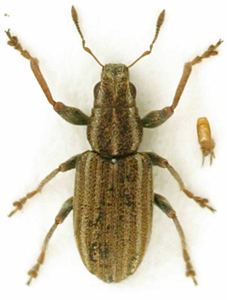Pests
Sitona lineatus L. - Pea leaf weevil.
Systematic position.
Class Insecta, Order Coleoptera, Family Curculionidae, Genus Sitona. Closely related to S. tibialis Hbst., S. suturalis Steph., S. ononidis Scharp.Biological group.
The pests of leguminous grain crops and perennial leguminous grasses.Morphology and biology.
Body length, 3-5 mm. Eyes large, moderately convex. Rostral dorsum in apical part subparallel, strongly broadened toward eyes. Prothorax broadest behind the middle, usually distinctly transverse. Body covered with gray or coppery scales and short thin setae. Odd interstriae of elytra, as a rule, are lighter. Mating and oviposition occur from spring until the end of June and then the beetles begin to die. Produce no more than 3600 eggs. Females lay whitish-yellow eggs on plants or soil surface. Up to 80-90% of eggs perish during dry hot weather. Hatching larvae feed on root tubercles, eating them from the inside. Larvae develop over 30-45 days depending on the temperature. Pupation in soil cradles at a depth of 10-15 cm at the end of June and the beginning of July. The pupa development lasts 8-11 days. Light-colored young beetles emerge from the beginning of July until the beginning of August. Adults enter winter diapause at the end of August-September. Warm humid springs, summers and winters, without sudden fluctuations in temperature, are the most favorable for the pea leaf weevil.Distribution.
S. lineatus inhabits Europe, Canary Islands, northern Africa, Israel and was introduced into the USA. In the former USSR it is widely distributed from the southern state border to latitude 63-64°N in the European part and 56-58°N in the Asian part. It was first found in the Russian Far East in 1979.Ecology.
Moderately hygrophilous. Everywhere monovoltine. Beetles usually hibernate under the rosettes of wild and cultivated perennial leguminous plants, sometimes burying in the soil. Spring activity of the beetles begins with under average air temperatures of 12-14°C and soil surface temperatures of 19-20°C. Ground migrations start with the beginning of perennial leguminous vegetation and flight begins when shoots of leguminous grasses appear. It feeds on leaves and stems of shoots beginning in March-May with the greatest intensity of feeing furing May-June. Population density in the wild depends on the activity of entomophages, e.g., predators; Harpalus pubescens Mull. and Philonthus ebeninus Grav and parasites of adult beetles; Pygostolus falcatus Nees., Perilitus labilis Ruthe. All phases of insect development may be infected by mycosis of Mycetosporidium spp., adult beetles by "white fungus" Beauweria bassiana (Bals.), and larvae and pupae by Metarrhizium anisopliae (Metsch.).Economic significance.
In the former USSR the pea leaf weevil causes the greatest damage to pea, vetch, lentil, and fodder-beans. During the years of mass outbreak the pest population density reaches 50-70 specimens per 1 square meter. Elimination of root tubercles by larvae decreases the nitrogen accumulation rate in plants and soil. Feeding of adults and larvae on leaves and roots during dry and hot springs decreases the harvest significantly. Control measures include sowing the annual leguminous plants for grain at the earliest time; using fertilizations for the first five weeks causes leaf development acceleration; sowing the annual leguminous plants for grain after the perennial leguminous grasses in crop rotation; plowing fields after harvesting; insecticide treatments of plants on attractive strips after harvesting.Reference citations:
Freude H., Harde K.W., Lohse G.A. 1981. Keys to families and genera for adult males and females. Krefeld: Goecke & Evers. 310 p. (In German)Petrukha O.I. 1969. The pea weevils of the genus Sitona Germ. of the USSR fauna, damaging leguminous crops. Leningrad: Nauka. 255 pp. (In Russian)
Shchegolev V.N., ed. 1955. Agricultural Entomology. Leningrad-Moscow: Gos. Izd. Selskokhoz. Lit. 616 pp. (In Russian)


